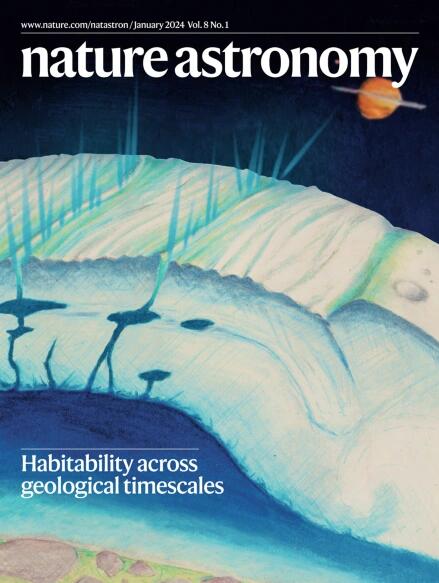从21厘米信号确定第一批恒星的质量分布
IF 14.3
1区 物理与天体物理
Q1 ASTRONOMY & ASTROPHYSICS
引用次数: 0
摘要
第一批恒星的形成和随后的x射线双星群代表了宇宙状态的一个基本转变,因为它从接近均匀的结构演变为丰富的坍缩结构,如星系。由于缺乏直接观测,这些恒星的性质仍然高度不确定。在这里,通过考虑第一批恒星及其残余x射线双星对宇宙21厘米信号的影响,我们证明了未来的观测有可能提高我们对这些天体的理解。我们发现,用宽波束辐射计(如REACH)对21厘米的全球信号进行25 mK的灵敏度测量,或者用SKA-Low对21厘米的功率谱进行3000 h的前景回避观测,可以对第一颗恒星的质量分布提供3σ约束。这样的测量将填补我们对早期宇宙理解的一个关键空白,并有助于解释高红移星系的观测结果。本文章由计算机程序翻译,如有差异,请以英文原文为准。


Determination of the mass distribution of the first stars from the 21-cm signal
The formation of the first stars and the subsequent population of X-ray binaries represents a fundamental transition in the state of the Universe as it evolves from near homogeneity to being abundant in collapsed structures such as galaxies. Due to a lack of direct observations, the properties of these stars remain highly uncertain. Here, by considering the impact of the first stars and their remnant X-ray binaries on the cosmological 21-cm signal, we demonstrate that upcoming observations have the potential to improve our understanding of these objects. We find that a 25 mK sensitivity measurement of the 21-cm global signal by a wide-beam radiometer, such as REACH, or 3,000 h of foreground avoidance observations of the 21-cm power spectrum by SKA-Low, could provide 3σ constraints on the mass distribution of the first stars. Such measurements will fill a critical gap in our understanding of the early Universe and aid in interpreting high-redshift galaxy observations. Next-generation radio telescopes, such as the Square Kilometre Array, will be able to reveal the mass distribution of the first stars in the Universe by detecting their impact on a faint radio signal of hydrogen atoms from Cosmic Dawn.
求助全文
通过发布文献求助,成功后即可免费获取论文全文。
去求助
来源期刊

Nature Astronomy
Physics and Astronomy-Astronomy and Astrophysics
CiteScore
19.50
自引率
2.80%
发文量
252
期刊介绍:
Nature Astronomy, the oldest science, has played a significant role in the history of Nature. Throughout the years, pioneering discoveries such as the first quasar, exoplanet, and understanding of spiral nebulae have been reported in the journal. With the introduction of Nature Astronomy, the field now receives expanded coverage, welcoming research in astronomy, astrophysics, and planetary science. The primary objective is to encourage closer collaboration among researchers in these related areas.
Similar to other journals under the Nature brand, Nature Astronomy boasts a devoted team of professional editors, ensuring fairness and rigorous peer-review processes. The journal maintains high standards in copy-editing and production, ensuring timely publication and editorial independence.
In addition to original research, Nature Astronomy publishes a wide range of content, including Comments, Reviews, News and Views, Features, and Correspondence. This diverse collection covers various disciplines within astronomy and includes contributions from a diverse range of voices.
 求助内容:
求助内容: 应助结果提醒方式:
应助结果提醒方式:


